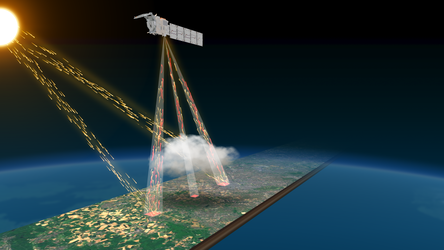Accept all cookies Accept only essential cookies See our Cookie Notice

About ESA
The European Space Agency (ESA) is Europe’s gateway to space. Its mission is to shape the development of Europe’s space capability and ensure that investment in space continues to deliver benefits to the citizens of Europe and the world.
Highlights
ESA - United space in Europe
This is ESA ESA facts Member States & Cooperating States Funding Director General Top management For Member State Delegations European vision European Space Policy ESA & EU Space Councils Responsibility & Sustainability Annual Report Calendar of meetings Corporate newsEstablishments & sites
ESA Headquarters ESA ESTEC ESA ESOC ESA ESRIN ESA EAC ESA ESAC Europe's Spaceport ESA ESEC ESA ECSAT Brussels Office Washington OfficeWorking with ESA
Business with ESA ESA Commercialisation Gateway Law at ESA Careers Cyber resilience at ESA IT at ESA Newsroom Partnerships Merchandising Licence Education Open Space Innovation Platform Integrity and Reporting Administrative Tribunal Health and SafetyMore about ESA
History ESA Historical Archives Exhibitions Publications Art & Culture ESA Merchandise Kids Diversity ESA Brand Centre ESA ChampionsLatest
Space in Member States
Find out more about space activities in our 23 Member States, and understand how ESA works together with their national agencies, institutions and organisations.
Science & Exploration
Exploring our Solar System and unlocking the secrets of the Universe
Go to topicAstronauts
Missions
Juice Euclid Webb Solar Orbiter BepiColombo Gaia ExoMars Cheops Exoplanet missions More missionsActivities
International Space Station Orion service module Gateway Concordia Caves & Pangaea BenefitsLatest
Space Safety
Protecting life and infrastructure on Earth and in orbit
Go to topicAsteroids
Asteroids and Planetary Defence Asteroid danger explained Flyeye telescope: asteroid detection Hera mission: asteroid deflection Near-Earth Object Coordination CentreSpace junk
About space debris Space debris by the numbers Space Environment Report In space refuelling, refurbishing and removingSafety from space
Clean Space ecodesign Zero Debris Technologies Space for Earth Supporting Sustainable DevelopmentLatest
Applications
Using space to benefit citizens and meet future challenges on Earth
Go to topicObserving the Earth
Observing the Earth Future EO Copernicus Meteorology Space for our climate Satellite missionsCommercialisation
ESA Commercialisation Gateway Open Space Innovation Platform Business Incubation ESA Space SolutionsLatest
Enabling & Support
Making space accessible and developing the technologies for the future
Go to topicBuilding missions
Space Engineering and Technology Test centre Laboratories Concurrent Design Facility Preparing for the future Shaping the Future Discovery and Preparation Advanced Concepts TeamSpace transportation
Space Transportation Ariane Vega Space Rider Future space transportation Boost! Europe's Spaceport Launches from Europe's Spaceport from 2012Latest
EarthCARE in synergy
Thank you for liking
You have already liked this page, you can only like it once!
With the initial images from each of the instruments aboard ESA’s EarthCARE satellite now in hand, it's time to reveal how these four advanced sensors work in synergy to measure how clouds and aerosols influence the heating and cooling of our atmosphere.
The animation, which features data from 18 September 2024, shows the multispectral imager mapping different types of cloud and first features a thunderstorm over Milan, Italy, and then low marine clouds over the Baltic Sea and high-altitude cirrus cloud over Sweden. The broadband radiometer registers the reflected solar radiation as measured at the top of the atmosphere, where red corresponds to high values and blue to low values. The measured thermal radiation emitted from Earth is not shown in the animation. The cloud profiling radar takes a full vertical profile of the bulk of the thundercloud as it is more sensitive to water droplets and precipitation, while the cirrus cloud made of ice particles does not give a strong signal. However, these are detected by the atmospheric lidar, which clearly captures ice particles suspended at the top of both clouds. Both instruments are needed to retrieve the full top to bottom cloud profile as the synergy slide shows, overlapping all areas. With this at hand, EarthCARE’s synergistic data products are enabled, such as the total water content in the atmosphere.
The overall heating effect of cirrus clouds, particularly in their upper layers, is evident where the clouds absorb both solar radiation as well as thermal radiation from the Earth’s surface. This warming effect is interrupted where the cloud thickens and larger ice particles form, blocking the thermal radiation being emitted from Earth’s surface. In these denser regions, the cloud top cools by emitting thermal radiation into space. Despite these localised cooling effects, cirrus clouds contribute to the overall warming of the atmosphere.
Read full story: EarthCARE synergy reveals the power of clouds and aerosols
-
CREDIT
ESA - European Space Agency -
LICENCE
ESA Standard Licence
-
Closed captions available Captions and subtitles are available (automatically generated by YouTube) - select your language using the YouTube player controls. A non-YouTube version is available using the 'download' button above.
-
Animation
-
-
-
-

EarthCARE detects atmospheric heating

EarthCARE

EarthCARE’s broadband radiometer

EarthCARE over desert dust















 Germany
Germany
 Austria
Austria
 Belgium
Belgium
 Denmark
Denmark
 Spain
Spain
 Estonia
Estonia
 Finland
Finland
 France
France
 Greece
Greece
 Hungary
Hungary
 Ireland
Ireland
 Italy
Italy
 Luxembourg
Luxembourg
 Norway
Norway
 The Netherlands
The Netherlands
 Poland
Poland
 Portugal
Portugal
 Czechia
Czechia
 Romania
Romania
 United Kingdom
United Kingdom
 Slovenia
Slovenia
 Sweden
Sweden
 Switzerland
Switzerland


























